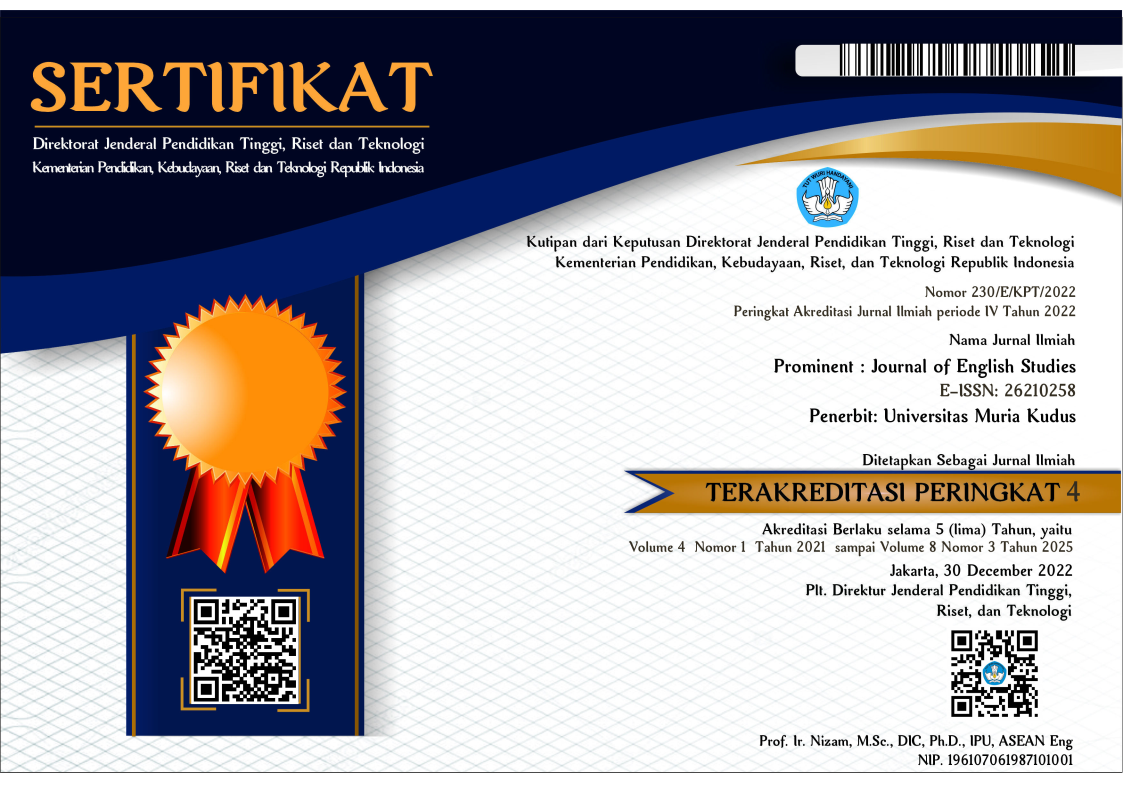TYPES OF MOOD USED BY THE LECTURER IN TEACHING READING: A SYSTEMIC FUNCTIONAL LINGUISTIC ANALYSIS
Abstract
Teaching Reading is a way to develop students’ awareness and to facilitate students to learn the reading skill in order to develop students engaged with the text they read in a meaningful way. In teaching Reading, the lecturer used several types of mood to make the students understand the materials. This study is aimed at describing the types of mood used by the lecturer in teaching two Reading classes in a private university in Semarang, Central Java, Indonesia. This study used qualitative research design since it describes certain phenomenon that is types of mood used by the lecturer in teaching Reading. The setting of this research is in English Department, Universitas Dian Nuswantoro Semarang, Central Java, Indonesia. The data are in the forms of utterances used by the lecturer in teaching Reading. Data collection was done by observing and taking notes on the teaching and learning process of Reading, video recording the teaching and learning process of Reading, viewing the data to show the completeness of the data, and transcribing the recorded data into the written forms. The were analyzed using qualitative data analysis offered by Creswell (2009), those are organizing and preparing data, coding and segmenting the written data into clauses, identifying the type of mood, classifying the type of mood, and interpreting the data. The result showed that the type of mood mostly used by the lecturer in teaching Reading is declarative because the lecturer gives much information to the students to make the students understand the materials. Other types of mood used are interrogative and imperative ones.
Keywords
Full Text:
PDFReferences
Amalia, Mustika, et.al. (2018). An Analysis of Domain Mood and Modaality of Interpersonal Meaning in Susilo Bambang Yudhoyono’s (SBY’s) Speech. English Language Teaching Education Journal (ELTEJ). Vol. 1. No.1. August 2018-pp.22-28.
Anderson, Neil J. (2005). Fluency in L2 Reading and Speaking. TESOL 2005 colloquium.
Butt, David, et.al.. (2001). Using Functional Grammar: An Explorer's Guide Second Edition. Sydney: National Centre for English Language Teaching and Research Macquarie University.
Creswell.J.W. (2009). Research Design: Qualitative, Quantitative, and Mix Method Approaches (3rd Edition). United States of America: Sage Publications, Inc.
Derewianka, Beverly. (1990). Exploring How Texts Work. Australia: Primary English Teaching Association
Eggin, Suzanne. (1994). An Introduction to Systemic Functional Linguistics. London: Printer Publishers.
Gerot, Linda and Wignell, Peter. (1994). Making Sense of Functional Grammar. New South Wales: Gerd Stabler.
Halliday, M.A.K. (1994). An Introduction to Functional Grammar. Second Edition. London: Edward Arnold.
Halliday, M.A.K. and C.M.I.M. Matthiessen. (1999). Construing Experience Through Meaning: A Language – Based Approach to Cognition. London: Continuum.
Harmer, Jeremy. (1998). How to Teach Writing. Essex: Pearson Education.
Harmer, Jeremy, (2001). The Practice of English Language Teaching. 4rd Edition. Longman.
Matthiessen, C.M.I.M. (1995). Lexicogrammatical Cartography: English Systems. Tokyo: International Language Sciences Publishers.
Putri, G. Jayanti.& Muhdi, Setiono. (2018). Mood Analysis of Financial Services taglines : A SFL approach. UI. Proceeding of Social Science and Humanities.
Richards, J.C., & Renandya, W.A. (2002).Methodology in language teaching: An anthology of current practice. Cambridge:Cambridge University Press.
DOI: https://doi.org/10.24176/pro.v4i1.5778
Refbacks
- There are currently no refbacks.
Prominent Journal of English Studies is licensed under a Creative Commons Attribution-ShareAlike 4.0 International License.
Dedicated to:

in Collaboration with APSPBI:





